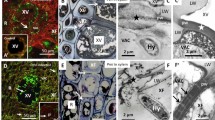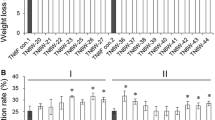Abstract
Both decay and disease of trees are of great economic importance to the commercial wood products industry. Certain micro-organisms such as the white-rot fungi can literally live upon wood via their abilities to secrete cellulolytic and ligninolytic enzymes (Highley and Kirk, 1979). The capacity of white-rot fungi to degrade lignin involves in part their elaboration of an extra-cellular polyphenol oxidase (Agrios,.1978; Highley and Kirk, 1979; Nobles, 1958, 1965).
Access this chapter
Tax calculation will be finalised at checkout
Purchases are for personal use only
Preview
Unable to display preview. Download preview PDF.
Similar content being viewed by others
References
Agrios, G.N. (1978). Plant Pathology. 2nd ed. Academic Press, N.Y.
Alfenas, A.C., Hubbes, M. and Couto, L. (1982). Effect of phenolic compounds from Eucalyptus on the mycelial growth and conidial germination of Cyphonectria cubensis. Can. J. Bot., 60, 2535–2541.
Bega, R.V. and Tavy, J. (1966). Influence of pine root oleoresis on Fomes annosus. Phytopathol., 56, 870.
Cheo, P.C. (1982). Effects of tannic acid on rhizomorph production by Armillaria mellea. Phytopathol., 72, 676–679.
Davidson, R.W., Campbell, W.A. and Blaisdell, V.T. (1938).
Differentiation of wood-decaying fungi by their reactions on gallic or tannic acid medium. J. Agric. Res., 57, 683–695.
Dix, N.J. (1979). Inhibition of fungi by gallic acid in relation to growth on leaves and litter. Trans. Br. Mycol. Soc., 73, 329–336.
Fries, N. (1973). Organic compounds on growth and development of fungi. Trans. Br. Mycol. Soc., 60, 1–21.
Hart, J.H. and Shrimpton, D.M. (1974). Role of stilbenes in resistance of wood-decay. Phytopathol. 69, 1138–1142.
Highley, T.L. and Kirk, T.K. (1979). Mechanism of wood decay and the unique features of heart-rot. Phytopathol., 69, 1151–1156.
Hofman, K.H. and Schauer, F. (1988). Utilization of phenol by hydrocarbon assimilating yeast. Antionie Van Leewenhoek, 54, 179–188.
Kuc, J., Ullstrup, A.J., and Quackenbush, F.W. (1955). Production of fungistatic substances by plant tissue after inoculation. Sci., 122, 1186–1187.
Li, C.Y., Lu, K.C., Nelson, E.E., Bollen, W.B. and Trappe, J.M. (1969). Effects of phenolic and other compounds on growth of Poria wierdii in vitro. Microbios., 1, 305–311.
Lindberg, G. (1949). Influence of enzymatically oxidized gallic acid on the growth of some hymenomycetes. Svensik Forestalia Svecrca, 29, 1–95.
Link, K.P., Angell, H.R. and Walker, J.C. (1929). The isolation of protocatechuic acid from pigmented onion scales and its significance in relation to disease resistance in onions. J. Biol. Chem., 81, 369–365.
Marbach, I., Harel, E. and Mayer, A.M. (1983). Inducer and culture medium dependent properites of extracellular laccase from Botrytis cinerea. Phytochem., 22, 1535–1538.
Nobles, M.R. (1958). A rapid test for extracellular oxidase in culture of wood inhabiting hymenomycetes. Can. J. Bot., 36, 91–99.
Nobles, M.K. (1965). Identification of cultures of wood inhabiting hymenomycetes. Can. J. Bot., 43, 1097–1139.
Rennefelt, E. and Nachi, G. (1955). The fungicidal activity of some constituents from heartwood of conifers. Svensk Bot. Tidski, 49, 419–432.
Robbins, W.J. and Harvey, A. (1958). Wood, tomato and malt extract and growth of some basidiomycetes. Mycologia, 50, 742–752.
Shain, L. (1967). Resistance of sapwood in stems of loblolly pine to infection by Fomes annosus. Phytopathol., 57, 1034–1045.
Shigo, A.L. (1974). Relative abilities of Phialophora melinii, Fomes connatus and F. igniarius to invade freshly wounded tissues of Acer rubrum. Phytopathol., 64, 708–710.
Shortle, W.C., Tattar, T.A. and Rich, A.E. (1971). Effects of some phenolic compounds on the growth of Phialophora melinii and Fomes connatus. Phytopathol., 61, 552–555.
Smith, K.T., Blanchard, R.O. and Shortle, W.C. (1981) Postulated mechanism of biological control of decay fungi in red maple wounds treated with Trichoderma harzianum. Phytopathol., 71, 496–498.
Snedecor, G.W. and Cochran, W.G. (1979). Statistical Methods. Iowa State University Press, Ames, Iowa.
Taylor, R., Llewellyn, G.C., Mayfield, J.E., Shortle, W.C. and Dashek, W.V. (1987a). Attempts to determine whether the products of extracellular polyphenol oxidase modulate the catechol-induced bimodal growth response of Coriolus versicolor. Biodeteridration Research I, pp. 43–62, Plenum Press, NY.
Taylor, R., Llewellyn, G., Mayfield, J.E., Shortle, W.C. and Dashek, W.V. (1987b). Time-dependent appearance of extracellular polyphenol oxidase in relation to the bimodal growth response of Coriolus versicolor to catechol. Biodeterioration Research I, pp. 63–74, Plenum Press, NY.
Williams, A.H. (1963). Enzyme inhibition by phenolic compounds. Ina Enzyme Chemistry of Phenolic Compounds. pp. 87–95. ( J.B. Pridham, ed.). Pergamon Press, Oxford, London, N.Y. and Paris.
Author information
Authors and Affiliations
Editor information
Editors and Affiliations
Rights and permissions
Copyright information
© 1989 Plenum Press, New York
About this chapter
Cite this chapter
Taylor, R. et al. (1989). In Vitro Growth of Coriolus Versicolor, a Wood-Decay Fungus, Responds Differentially to Catechol and Tannic Acid. In: O’Rear, C.E., Llewellyn, G.C. (eds) Biodeterioration Research 2. Springer, Boston, MA. https://doi.org/10.1007/978-1-4684-5670-7_39
Download citation
DOI: https://doi.org/10.1007/978-1-4684-5670-7_39
Publisher Name: Springer, Boston, MA
Print ISBN: 978-1-4684-5672-1
Online ISBN: 978-1-4684-5670-7
eBook Packages: Springer Book Archive




